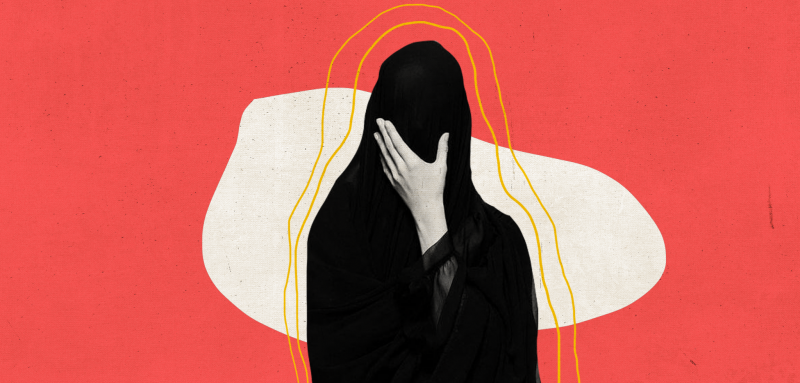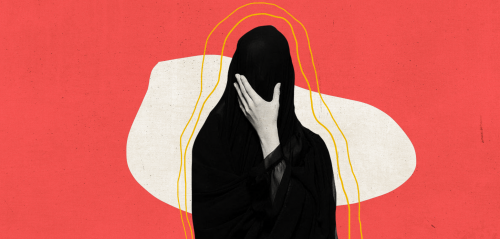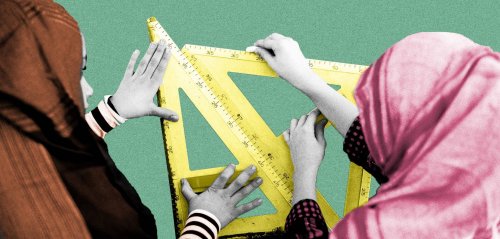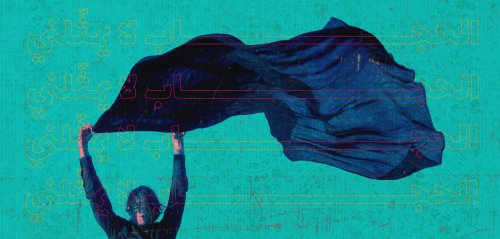Whenever an Egyptian actress or artist takes off her veil, it sparks controversy in both the popular and cultural spheres. This has happened with artists like Soheir Ramzi, Shahira, Hala Shiha, Hanan, Sabreen, Eman El-Asy, Nourhan, and Abeer Sabry, as well as with political activists like Nawara Negm and Esraa AbdelFattah.
This occurs because the issue of the hijab represents one of the most important problems in contemporary Islamic thought, given its implications for the freedom of women and children and human rights on the one hand, and the relationship between the sexes on the other, as well as the nature of the state, whether it is secular or religious.
Hijab in history
Historically, "women in Persia held a high position during the Zoroastrian era. They walked among the people with full freedom and their faces uncovered, but their status declined in the period after. Upper-class women dared not leave their homes except in veiled clothing, and they were not allowed to openly mingle with men. Even their closest relatives, such as fathers and brothers, were forbidden from seeing them. Women were never mentioned or depicted in ancient Persian engravings or public statues," as recounted by Will Durant in his book "The Story of Civilization", revealing that depriving women of public appearance and interaction was not a fixed rule throughout the ages.
In his book "Hijab in History," the Jordanian writer Ayoub Abu Dayyeh distinguishes between the statuses of "free women" and "slave women" with regards to the veil. He states, "The veil was compulsory for free women in Assyria around the 12th century BC, while other women, such as slave women and those with a questionable reputation, were prohibited from wearing the veil under severe penalties." This distinction is also mentioned by Basma Kayal in her book "The Evolution of Women throughout History".
The idea of this distinction was analyzed and justified by Sheikh Muhammad Ali al-Sayis in his book "Tafsir Ayat al-Ahkam". He says, "Slave women, by nature of their work, had to go out more frequently, roam in markets and shops to serve their masters and meet their requirements. So if they were required to cover their faces and wear the veil whenever they went out, it would be burdensome and inconvenient for them. However, it was not the same for free women. They were obligated to remain in their homes and not to leave except in times of extreme necessity. They did not face a burden and inconvenience of veiling themselves as the slave women did."
Recent spread of the hijab
Egyptian writer and researcher Emad AbdelHafez tells Raseef22, "The phenomenon of wearing the hijab is considered the norm now since it started to emerge in the 1970s and then became deeply rooted as a social and religious practice, and thus began to be automatically embraced by a large segment of society. However, the more recent phenomenon worthy of study is the act of many women and girls taking off the headscarf, especially in the period following 2011. This is a growing phenomenon, as evidenced by the numerous testimonies shared by women about their experiences with wearing and removing the hijab." However, this issue cannot be accurately determined due to the absence of relevant statistics.
When discussing the emergence of the hijab in the 1970s influenced by political Islam, especially in Egypt during the Sadat era, what's being referred to is its widespread return after a few decades of decline, especially in cities and urban areas.
On the other hand, the Egyptian writer and researcher Hossam el-Haddad views the matter differently. He tells Raseef22, "We often measure the wearing and removal of the headscarf in relation to cities, not the Egyptian countryside, especially major cities like Cairo, Giza, and Alexandria. This is an incorrect measure because the phenomenon of the spread of the hijab and its advocates is still more widespread when compared to its removal. This is a natural consequence of the growing conservatism within society, especially among the lower socioeconomic classes, for whom wearing the hijab is influenced by their economic realities." In other words, these lower classes have adopted a distinct appearance compared to the upper, middle, and elite classes, among whom the hijab has been increasingly removed over the past century. Consequently, the act of covering one's hair has acquired a social and class dimension, in addition to its religious significance during the Islamic Sahwa (awakening).
In the hadiths of the Prophet, authentic narrations state that women did not wear the hijab in front of the Messenger. Rather, they would sit in front of him with their hair and heads uncovered.
Whatever the case, there is agreement that wearing the hijab remains a widespread and prevalent phenomenon. AbdelHafez believes that there are three factors behind this. Firstly, it is the erosion of the positive mental image of religious figures, especially representatives of the Islamist movement. Prior to the revolution, people held a certain level of trust in them, but the performance of the Islamist movement and its various factions after the revolution shaken their image after people witnessed the nature of its arrogant and crisis-inducing rhetoric.
The second factor, he continues, is the growing sense of disillusionment. The level of awareness increased after the revolution, due to the spread of social media and more space for criticizing religious thought. The third factor is rebellion against societal guardianship. According to him, many veiled women wear the hijab under pressure from their families without personal choice, and they wait for the appropriate moment to liberate themselves from this coercion.
Disagreements within Al-Azhar
In a fatwa issued in December 1979, Sheikh Gad Al-Haq Ali Jad Al-Haq, the former Sheikh of Al-Azhar and the Grand Mufti of Egypt, said, "The religious texts require Muslim women to cover their entire bodies except for the face and hands, which do not need to be covered. This is the opinion of most Muslim scholars, and the husband and any guardian, such as the father, brother, or son, have the authority to compel a woman to comply. The husband has the right over his wife, and if she disobeys his guardianship, to admonish her, then abstain from intimacy, and in extreme cases, discipline her with non-severe beating while exercising patience in advising and guiding her" (Fatwas of Al-Azhar 1/315).
From the same perspective, former head of the Al-Azhar Fatwa Committee, Sheikh Atiya Saqr, issued a fatwa in May 1979 stating, "The hijab for women is mandated by the Quran and Sunnah, and if Allah and His Messenger have commanded it, its implementation does not depend on anyone's permission. A husband who orders his wife to remove it is sinful because he is commanding her to commit disobedience, similar to telling her not to pray or fast, which is a great sin because he is promoting wrongdoing. Therefore, it is forbidden for the wife to obey him in that matter, as there is no obedience to a creature in disobeying the Creator" (Fatwas of Al-Azhar 9/479).
"Hijab isn't part of religion. There's no clear or explicit religious text that talks about women's hair, especially in the Quran. Most hadiths discussing covering women's hair are weak, and may be influenced by older civilizations and religions predating Islam"
However, in contrast to this view, Dr. Saad El-Din El-Hilali, Professor of Comparative Jurisprudence at Al-Azhar University, disagrees and believes that "all these opinions are human-based, founded on human jurisprudence rather than divine jurisprudence. They do not originate from the Quran but rather from weak hadiths that are questionable in their authenticity, such as the famous hadith: "O Asma', when a woman reaches the age of menstruation, it does not suit her that she displays her parts of body except this and this, and he pointed to his face and hands."
El-Hilali explained his opinion in detail on the "Al-Hekaya" TV program aired on MBC Egypt with host Amr Adib on June 27 and July 5, 2022. He mentioned authentic hadiths that state that women did not wear the hijab in front of the Prophet; rather, they would sit before him with their hair and heads uncovered. For example, the hadith narrated by Sa'd ibn Abi Waqqas states that Umar ibn Al-Khattab sought permission to enter upon the Messenger of Allah, and there were women asking him questions and seeking his advice with loud voices. When they heard Umar approaching, they quickly covered themselves with their hijabs. The Prophet smiled when he saw Umar, and when Umar asked him about the women's situation, he looked at them and said, 'O enemies of yourselves, you fear me while you do not fear the Messenger of Allah?' They said, 'Yes, because you are harsher and sterner'."
The gist of this hadith is that women did not wear the hijab in front of the Prophet, and they feared Umar because they knew he was strict. This is a human reason and not an Islamic one.
El-Hilali concluded his opinion by pointing out that "the ancient scholars did not rule on the obligation of the hijab, but this term emerged with the Salafi awakening of the Muslim Brotherhood in the 1970s. The ancient scholars only differed in their understanding of 'covering the awrah' and 'visible adornment'."
Raseef22 is a not for profit entity. Our focus is on quality journalism. Every contribution to the NasRaseef membership goes directly towards journalism production. We stand independent, not accepting corporate sponsorships, sponsored content or political funding.
Support our mission to keep Raseef22 available to all readers by clicking here!
Interested in writing with us? Check our pitch process here!










Join the Conversation
ذوالفقار عباس -
1 hour agoا
Hossam Sami -
2 hours agoصعود "أحزاب اليمين" نتيجة طبيعية جداً لرفض البعض; وعددهم ليس بالقليل أبداً. لفكرة الإندماج بل...
Anonymous user -
1 day agoرائع و عظيم ..
جيسيكا ملو فالنتاين -
5 days agoزاوية الموضوع لطيفة وتستحق التفكير إلا أنك حجبت عن المرأة أدوارا مهمة تلعبها في العائلة والمجتمع...
Bosaina Sharba -
1 week agoحلو الAudio
شكرا لالكن
رومان حداد -
1 week agoالتحليل عميق، رغم بساطته، شفاف كروح وممتلء كعقل، سأشاهد الفيلم ولكن ما أخشاه أن يكون التحليل أعمق...